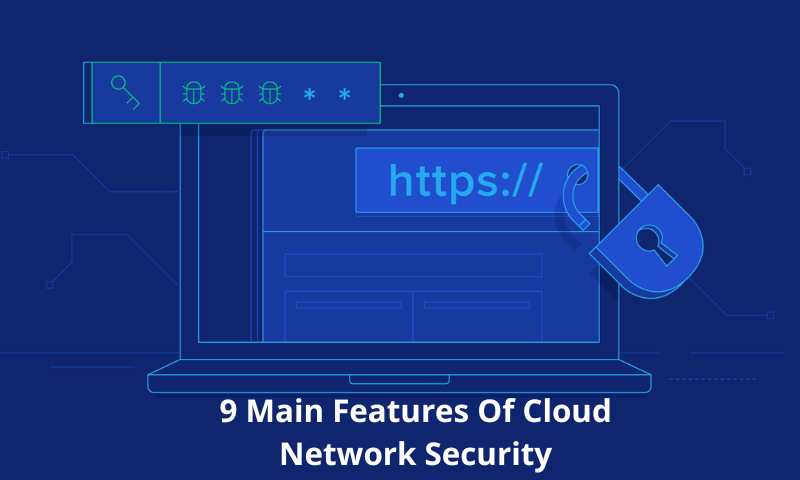What exactly is Cloud Network Security? Cloud infrastructure necessitates the same level of safety as an organization’s on-premises environment. Cloud network security is a fundamental layer of cloud security that protects the data, applications, and IT resources deployed in enterprise cloud environments, and also the traffic flowing between cloud deployments and the enterprise’s intranet and on-premises data centers.
On-premises enterprise networks employ network security solutions for threat detection prevention, restricting access to company systems, enforcing security policies, and performing internal network segmentation. Cloud network security protects cloud infrastructure as well as networks in the same way that enterprise-grade security does.
Why is Cloud Network Security significant?

As businesses transition to cloud-based infrastructure, they must safeguard these assets in accordance with business security policies as well as applicable regulations. Traditional perimeter-based defenses cannot properly prevent cloud-based infrastructure, and most public and private cloud vendors’ security tools do not fulfill enterprise security requirements.
Cloud network security solutions fill a critical security hole in the cloud. They enable businesses to keep up with the same degree of security monitoring as well as threat prevention that they had in their on-premises environment, despite the network perimeter dissolving. This is critical to an organization’s ability to fulfill its responsibilities under the cloud-communicated responsibility model while also ensuring corporate cybersecurity but also regulatory compliance.
Customers that utilize the same security vendor for on-premises and cloud deployments should make sure that they can manage all of their network security from a single point of contact, increasing efficiency and lowering TCO as well as corporate risk.
What is the Process of Cloud Network Security?
To route traffic through an organization’s cloud-based infrastructure, cloud environments utilize software-defined networking (SDN). Cloud network security solutions incorporate cloud platforms as well as virtualization solutions, as well as deploy virtual security gateways, to provide the controls and visibility required for network traffic segmentation, security monitoring, and advanced threat prevention. These virtual security portals perform and have the same capabilities as on-premise security gateways, but they are virtual as well as hosted in the cloud.
Features of Cloud Network Security

A cloud network security solution ought to offer an organization the same level of security in the cloud that it does on-premises. To accomplish this, a cloud network security solution has to possess the following key capabilities:
- Cloud network security services include a Next Generation Firewall (NGFW), anti-virus, application control, intrusion prevention system (IPS), URL filtering, data loss prevention (DLP), identity awareness, and anti-bot.
- To resolve the fast-changing threat landscape, cloud network security solutions should provide zero-day attack protection.
- SSL/TLS Traffic Inspection: As network traffic becomes more encrypted, detecting and blocking malicious connections becomes more difficult. Security solutions for networks must provide efficient SSL/TLS traffic checking with low latency.
- Network segmentation is critical for reducing corporate cyber risks and the possibility of lateral forces by an attacker. Cloud network security solutions enable cloud network segmentation and micro-segmentation.
- Cloud adoption broadens the corporate digital attack surface but also raises the difficulty of security monitoring as well as threat management. To maximize operational efficiency, cloud network security solutions should integrate with an organization’s existing on-premises solutions. Security teams should ideally be capable of handling all cloud and on-premises network security from a centralized location.
- Automation: Cloud deployments are ephemeral and dynamic. A cloud solution that doesn’t support or enable automation. Any cloud solution which does not support high levels of automation is unsupportable and will be neglected by customers. Legacy security strategies that rely primarily on human intervention are incapable of dealing with the volume, velocity, and variety of today’s cybersecurity threats. Manual processes also are time-consuming as well as prone to error. Automation is critical for scalability as well as rapid threat response as cloud infrastructure expands and grows. Cloud network security solutions that are automated support rapid deployment, CI/CD workflow automation, and solution agility.
- Secure Remote Access: Because of the shift to remote work as well as cloud computing, remote workers require access to cloud-based assets. Cloud network security solutions should provide organizations with secure and scalable remote access to their cloud-based infrastructure.
- Sanitization of Potentially Malicious Content: Rather than blocking all conceivably malicious content, network security solutions must be capable of eliminating malicious, executable content as well as providing users with access to sanitized content.
- Third-Party Integrations: Cloud network security solutions work alongside a cloud provider’s existing tools and solutions. To maximize network monitoring, configuration management, and security automation, CNS tools should integrate with third-party solutions.
Network Security in the Public and Private Clouds
Certain cloud service models are best suited to addressing specific business and security needs as companies migrate to the cloud. For various use cases, businesses must choose between private and public cloud infrastructure, and they frequently implement a hybrid, multi-cloud environment that distributes resources across public and private cloud environments as well as on-premises infrastructure.
A solid cloud network security plan should protect both private and public cloud environments. This includes not only securing data flows entering and exiting the cloud environment, and also east-west flows between distinct cloud-hosted resources inside a single cloud deployment (also known as “lateral movement”).
